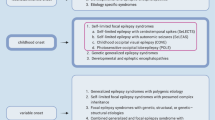Abstract
Purpose
Self-limited epilepsy with centrotemporal spikes, formerly called benign epilepsy with centrotemporal spikes, or rolandic epilepsy, is an age-related and well-defined epileptic syndrome. Since seizures associated with rolandic spikes are infrequent and usually occur during sleep, and repetitive or prolonged EEG recording for diagnostic purposes is not necessary for diagnosis, reports of ictal video-electroencephalographic seizures in this syndrome are rare. We aimed to show ictal video-EEG of typical rolandic seizures.
Methods
We report the ictal video-EEG recordings of two children with rolandic epilepsy who presented typical rolandic seizures during routine recording.
Results
Case 1: A 9-year-old boy, with normal development, had his first seizure at 8 years old, characterized by paresthesia in his left face, blocking of speech, and drooling. Carbamazepine was started with seizure control. Case 2: A 10-year-old boy, with normal development, started with focal seizures during sleep, characterized by eye and perioral deviation, and speech arrest at age of 7. He started using oxcarbazepine. Both patients underwent routine electroencephalography for electroclinical diagnosis and presented a seizure.
Conclusion
Although self-limited epilepsy with centrotemporal spikes is a very common epileptic syndrome, seizure visualization is very difficult, and these videos may bring didactical information for recognition of this usual presentation of benign childhood focal epilepsy.


Similar content being viewed by others
Date availability
The data and material are available with the corresponding author.
References
Bernardina BD, Tassinari CA (1975) EEG of a nocturnal seizure in a patient with “benign epilepsy of childhood with Rolandic spikes”. Epilepsia 16:497–501. https://doi.org/10.1111/j.1528-1157.1975.tb06079.x
Capovilla G, Beccaria F, Bianchi A, Canevini MP, Giordano L, Gobbi G, Mastrangelo M, Peruzzi C, Pisano T, Striano P, Veggiotti P, Vignoli A, Pruna D (2011) Ictal EEG patterns in epilepsy with centro-temporal spikes. Brain Dev 33:301–309. https://doi.org/10.1016/j.braindev.2010.06.007
Clemens B (2002) Ictal electroencephalography in a case of benign centrotemporal epilepsy. J Child Neurol 17:297–300. https://doi.org/10.1177/088307380201700412
de Andrade DO (2005) Ictal electroencephalographic subclinical pattern in a case of benign partial epilepsy with centrotemporal spikes. Arq Neuropsiquiatr 63:360–363. https://doi.org/10.1590/s0004-282x2005000200033
Guerrini R, Pellacani S (2012) Benign childhood focal epilepsies. Epilepsia 53(Suppl 4):9–18. https://doi.org/10.1111/j.1528-1167.2012.03609.x
Gutierrez AR, Brick JF, Bodensteiner J (1990) Dipole reversal: an ictal feature of benign partial epilepsy with centrotemporal spikes. Epilepsia 31:544–548. https://doi.org/10.1111/j.1528-1157.1990.tb06104.x
Kanabar G, Sully M, Walsh K, Chawla K (2010) Seizure in benign epilepsy with centro-temporal spikes. Epileptic Disord 12:306–308. https://doi.org/10.1684/epd.2010.0346
Loiseau P, Beaussart M (1973) The seizures of benign childhood epilepsy with Rolandic paroxysmal discharges. Epilepsia 14:381–389. https://doi.org/10.1111/j.1528-1157.1973.tb03977.x
Panayiotopoulos CP (1993) Benign childhood partial epilepsies: benign childhood seizure susceptibility syndromes. J Neurol Neurosurg Psychiatry 56:2–5. https://doi.org/10.1136/jnnp.56.1.2
Panayiotopoulos CP, Michael M, Sanders S, Valeta T, Koutroumanidis M (2008) Benign childhood focal epilepsies: assessment of established and newly recognized syndromes. Brain 131:2264–2286. https://doi.org/10.1093/brain/awn162
Saint-Martin AD, Carcangiu R, Arzimanoglou A, Massa R, Thomas P, Motte J, Marescaux C, Metz-Lutz MN, Hirsch E (2001) Semiology of typical and atypical Rolandic epilepsy: a video-EEG analysis. Epileptic Disord 3:173–182
Author information
Authors and Affiliations
Corresponding author
Ethics declarations
Conflict of interest
The authors have no conflicts of interest to declare
Additional information
This work has not been published elsewhere, accepted for publication elsewhere, or under editorial review for publication elsewhere.
Publisher’s note
Springer Nature remains neutral with regard to jurisdictional claims in published maps and institutional affiliations.
Electronic supplementary material
ESM 1
Electroclinical patterns of typical seizures in self-limited epilepsy with centrotemporal spikes. Case 1 - Interictal EEG shows sharp wave discharges of high amplitude, activated during sleep, in centrotemporal regions bilaterally, synchronous, predominantly over the right hemisphere. Ictal EEG shows an electroclinical seizure in sleep, with ictal onset zone in the right anterior temporal region, characterized by a regular theta rhythm, which changes in frequency, amplitude, morphology and distribution field. Clinically, after 14 s of the ictal onset, a tonic seizure was observed in the left perioral region, with a later cephalic version to the left and tonic flexion of the ipsilateral upper limb, followed by clonic movements in left hemiface and upper limb, evolving to generalized tonic-clonic seizure, aborted spontaneously. Case 2 - Interictal EEG shows sharp wave discharges of high-amplitude, activated during sleep, in left temporal and temporo-parietal regions. Ictal EEG shows electroclinical seizure in sleep, with ictal onset zone in the left temporal region, characterized by rhythmic and regular theta-alpha waves to 7–9 Hz, over temporo-parietal regions, evolving to frontocentral regions with faster (beta) and then slower (theta-delta) frequencies in a total of 50 s. Clinically, after 24 s of the ictal onset a tonic crisis in the right perioral region was observed, with hemifacial clonias (right perioral and eyelid) 2 s after the onset of clinical manifestations. (WMV 30037 kb)
Rights and permissions
About this article
Cite this article
Ferrari-Marinho, T., Hamad, A.P.A., Casella, E.B. et al. Seizures in self-limited epilepsy with centrotemporal spikes: video-EEG documentation. Childs Nerv Syst 36, 1853–1857 (2020). https://doi.org/10.1007/s00381-020-04763-8
Received:
Accepted:
Published:
Issue Date:
DOI: https://doi.org/10.1007/s00381-020-04763-8




